There is often some contention in the martial arts between those that are more traditionally minded and those that are more modern in their approach. Traditional fighting arts are often the subject of criticism by Mixed Martial artists, researchers and skeptics. Some have even taken to public challenges of traditional teachers by amateur fighters. Traditional martial artist have in many cases responded by making arguments and apologies for lost fights and powers that don’t work on non-students, criticizing the modern method as being devoid of soul or art and that it is not compatible with the old ways.
These are of course the extreme examples in the community today, but they do affect many people’s perception and attitude toward the traditional and modern martial arts. To the extent where many practitioners see the two as being incompatible and are advocating to discard one or the other.
I disagree. The findings of science and specifically human movement science seem to confirm many of the observations of the old arts and of the teachers who developed the training regimens. There are certainly things that we mist reframe in light of new information, but all in all, the science backs up much of the traditional methods. As long as one is willing to redefine things a bit, the finding of modern research can offer explanations and reliable results where things were not so reliable before.
Some Basics of Human Movement Science
Human movement is a very complicated affair. Our bodies consist of thousands of constituent parts and chemical processes and yet somehow were are able to create movement and display athleticism through our bodies. In martial art, this can be argued to be 80-90% of all we do. Describing movement in martial arts has long been a problem to solve among martial artists. Teachers wish to record and transmit more information about this in writing, and students need references and objective markers to judge their own progress. Other areas of physical expression like dance have the same issues and goals. To describe, in as objective way as possible, the actions of the human body during certain mechanical events (movements).
Often traditional martial arts decry science in its relationship with them. Most of this centers around conversations of “Qi” and other esoteric concepts. Traditional explanations are also similarly looked at with scorn by the scientific community. The reality of the issue is that both are describing the same thing, one is just using different information than the other. But, I believe, that both systems are complimentary and can be used to augment each other rather than be at odds.
Human Movement Science
Human movement science is the branch oof Kinesiology that is concerned with the human body and its mechanics during movement. It seeks to describe these actions in as detailed manner as possible. This includes joints mechanics, muscle and motor unit functioning, exercise physiology, sport psychology, and any other factor that impacts human movement. Its discoveries, all relatively recent, have impacted much of what we intuitively believed even a few decades ago.
The Basics
The first place to start is to introduce the vocabulary that we use to describe movement in the human body. This vocabulary is very useful in describing movement in as clear a way as possible. However, anytime one tries to write down descriptions of movement, difficulties in reading it are inherent. Never the less, these are terms that have very objective criteria.
The terminology is based on the movement of joints according to their anatomical position and relative motion to the mid-lines of the body. “Distal” means away from the mid-line, “medial” means toward the mid-line. These terms are standardized for most researchers and can be used for most tasks. Special terminology is used for specialized motor units like hands and feet due to their unique movement qualities.
Planes of motion
The body is divided into three distinct cardinal planes of motion. These are the basics planes of motion that the human body (or kinetic chain) can move through. The planes can be further divided when speaking of limbs or specific part of the body. These are the cardinal planes used to describe global movement of the entire chain.
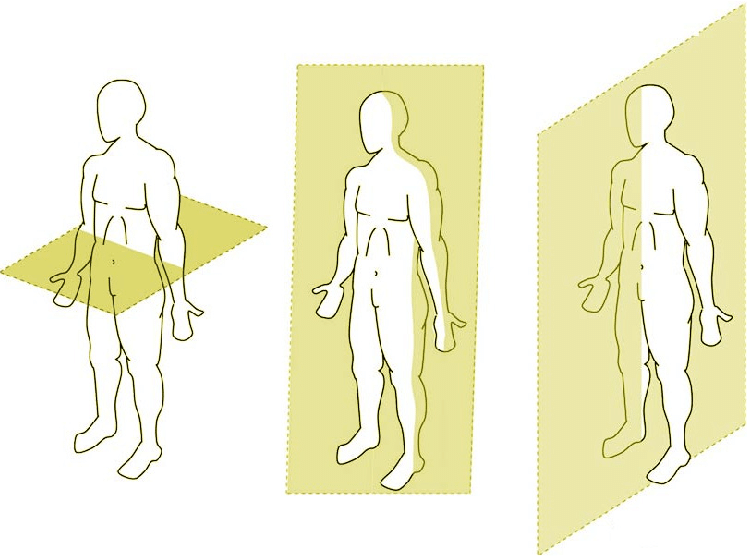
- frontal or coronal plane: this is the front and back of the body with the midline being lateral (to the side).
- sagittal or anteroposterior plane: This is the left and right sides of the body as divided down the midline of the body. This is called the median line of the body and usually passes through the naval and other structures.
- transverse or axial plane: This is the line between the upper and lower body. It corresponds to the waist and midsection of the body.
The sagittal and frontal planes are the most developed in the average person. These planes are situated vertically when we are standing (our most natural position according to our anatomy) and therefore very easy to stabilize and control. Movement in these planes are the most basic and common of movement patterns. Stabilization also occurs in these planes as the same mechanisms for creating movement should be able to stop or control the movement.
Classifications of movement
Once we have the anatomical planes that the motion is working in, we can further classify movements of the joints based on their action and structure. There are basically two types of motion in the limbs, linear and rotary. Linear motion goes between two points rotary goes around a point. (Rectilinear is a straight line and curvilinear is an arc. Like the difference between a jab and a hook).
Joints are classified based on the type of movement they allow:
- Angular motion. The synovial joints, the ones associated with movement in the limbs like the knee and elbow, use angular motion. This is the act of increasing or decreasing the degree of angle in the joint.
- Gliding motions occur with flat surfaces like those in the hand and wrist or the vertebral disks in the spine.
- Rotational motion happens in the longitudinal axis. Turning your head side to side causes rotation in the vertebrae of the neck.
- Abnormal motion is motion in a joint the exceeds or does not fulfill it’s mechanical criteria. “Hyper” is used for an excess of motion and “hypo” for a deficiency.
General/global types of movement in the body
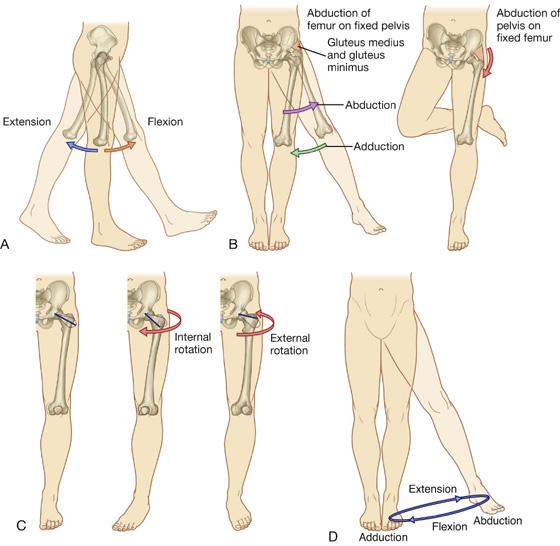
Basic movements of the hip 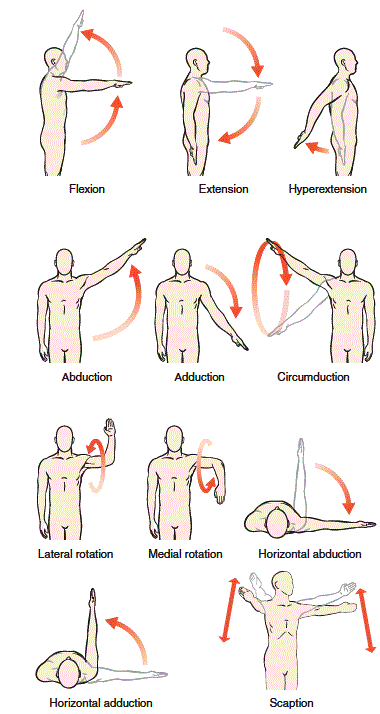
Basic movements of the shoulder
General motion of the body as described in science
- Flexion-the reduction in the angle between two body parts.
- Extension-the increase in angle between any two body parts.
- Abduction-the act of a body part moving away from the midline of the body.
- Adduction-the act of a body part moving toward the midline of the body.
- Elevation- movement in the upward direction.
- Depression-movement in the downward direction.
- External Rotation- rotation away from the midline of the body.
- Internal Rotation-rotation toward the midline of the body.
Circumduction
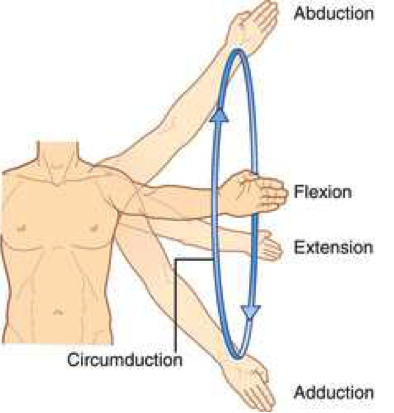
While the above movements often have muscles and structures devoted to them, one must always remember that movement happens simultaneously. Circumduction or “conical” movement. This is movement in a circle with one stable point as an axis. The arm in a throwing or punching movement is circumduction. The shoulder, hip, neck, wrist and ankle are all joints that are capable cicumduction. Shoulder and hip circumduction is the major player in martial arts and combat sports although attention should be paid to all of them.
Cricumduction, no matter where it occurs, is a combination of flexion, extension, abduction and adduction. In this way it is a foundational and a compound movement. Where all human movement is combination of these types, circumduction is fundamental to many of our primitive movement patterns.
Hand and Foot
The hand and foot need some special attention because of the their extreme ranges of motion. Both the wrist and ankle are extremely complex structures that are capable of a large number of movements many in 360 degrees. Because of this, things like flexion, which occurs in one plane of motion in joints like the elbow, are difficult to ascertain. Essentially, the positive and negative phases happen simultaneously. The top extends while the bottom flexes and vice versa. Generally, it is acceptable to only think about it in terms of flexion not extension.
The Hand and Wrist
Flexion and extension
Flexion can happen as palmer flexion or dorsiflexion technically, but usually palmer flexion (palm to the arm) is considered flexion of the wrist and dorsiflexion is considered extension.
Pronation and Supination
Pronation and supination usually refers to the position of a body laying down. Prone is face up Supine is face down. These terms are used to describe movements of the hand and foot and are very important for understanding the more complicated mechanics of these parts.
The forearms rotated inwards for pronation and outwards for supination. Or palm up versus palm down.
Deviation
Deviation is the tilting of the hand toward either the thumb (radial deviation) or the pinky (ulnar deviation).
The Foot and Ankle

Flexion at the Ankle
Plantar flexion is the pointing of the foot or decreasing the angle of the ankle and the back of the leg or heel. Dorsiflexion is bring the foot back toward the front of the leg.
Abduction and Adduction
Abduction and adduction refer to the front of the foot being pulled toward the midline of the body (adduction) or away from it (abduction).
Eversion and Inversion
This is the tilting of the foot in the frontal plane either toward the inside of the foot (inversion) or the outside edge (eversion).
Pronation and Supination
Pronation and Supination in the foot are actually complex compound movements consisting of degrees of flexion of the ankle, abduction/adduction of the fore foot, and inversion/eversion of the heel. Pronation twists the foot complex away from the midline and supination twists it toward the midline.
The Kinetic Chain
It is often assumed that because scientific discovery often includes a great deal of deconstruction and parsing of processes and operations, that it sees the human body as merely a collection separate moving pieces. This is not the case today. In the study of human movement the concept of the “kinetic chain” is applied to the human body. The premise is that the human movement system has one job in the larger context and that is to move kinetic energy though the body and its structures to accomplish work. These basic movements are accepted as being all connected. Gray Cook, trainer and researcher of human movement, has said “All movement is full body movement”.
The entire body can be called the kinetic chain, but actually the body consists of several chains depending on what is being done. The posterior chain is responsible for much of our power out put in lifting, acceleration, and jumping. The anterior chain resists the posterior helping to control the output and regulate the work done. These chains and their cousins are all defined but the way they move kinetic energy through the body.
These chains create two basic types of movement; open chains, meaning the distal part of the body is the one moving and the medial parts stabilized and closed chain movements which are those that the distal portion is not moving and the medial parts are. Simple examples of each is the difference between a straight bar curl and a pull up. The curl has the resistance being moved by the hand and the pull ups has one moving the body from the hand.
In martial arts another way to look at is that open chain movements use the momentum from the limb accelerated by the body. Closed chain techniques are those that use the ground and the stabilization of the body to produce the power. A hook kick would be an open chain movement while a side or push kick would be a closed chain movement. Open chain techniques depend on motion and speed to build their inertia while closed chain techniques use the ground to brace the body and transmit the force to the target.
Stabilization and movement-global versus local
The last set of terms we should introduce before going into the more complex areas of the science is the dichotomy between what is called “global” and “local” in the context of movement. When we say the term global, we mean that we are applying what ever it is were are talking about to a large and complex structure or a movement through space. Local is used when we mean something happening to a specific structure or the act of stabilizing that structure.
Stabilization is the opposite companion to movement. Any of the planes of motion must not only be free to move but also be able to decelerate and stop that movement. This is true of the entire body and its planes of motion and each constituent part with in the chain. The global expression of this emolument as represented in the planes of the body (global) are echoed in the smaller parts of the body(local). Fingers have midlines and ranges of motion with those planes relative to that midline. Causing movement in a joint is causing it to change relative position with the entire genetic chain (global). Stabilizing that joint does the opposite, resisting that change to keep the chain together (local).
In training terms, this is usually called deceleration or eccentric training. We will talk more about eccentric training when we discuss the muscle and neurological components of the movement system. Stabilization is an essential part of all movement in our bodies. Often our output of strength or speed is governed by how well our body feels it is able to stop that movement. If we cannot safely stop or control this motion our body may refuse to produce it.
It is important to know that each these articulations in the body are also stabilization pattens as well as motion. Flexion will resist extension, extension will revisit flexion. This interaction is the basis for most of the biomechanics that we use in martial arts and in every day life.
What is this for?
This is a descriptive system and it simply describes the component pieces of the way we move. With these simple components and basic ideas, any movement, no matter how complicated or other wise, maybe described in a moment to moment, objective manner. This should have obvious value to the martial artist. By learning more about the components of movement, allows one to advance their understanding beyond the mere deconstruction that occurs in the initial phases of discovery.
Besides providing the basic vocabulary to describe the more complicated processes and ideas, these basics have antecedents in the Chinese martial arts training. Many these are profound, but most are mundane. The reason for showing some the concepts overlap is not to give validity to anything, but simply to provide a basis of comparison and another set of observations. Truths are truths for the very reason they are true for every one.
For example; The intersection of the three planes is where the Dan Tian is traditionally placed in CMA. This makes a good deal of sense when looking at the information. The intersection of the three planes corresponds to the anatomical center of gravity in the lumbar spine. This is a result of the intersections of movement planes inherent in our bodies. This is very much the center of our bodies and it would be a fairly easy matter for one to observe this fact with the naked eye.
As we start to explore the ascending complexity of processes, we find more and more parallels between the training regimens of martial art and the recent discoveries of science. Beginning with a solid vocabulary to describe things leads to observations that show most systems are based on the same types of these observations. But, each school of thought brings a particular perspective and bank of experience. This allows the benefits to go both ways. We can already see the beginnings of Yin and Yang in the various dichotomies in the body. We can see concepts like the the liu he 六合 (six unities) and the Liu Gong 六弓 (six bows) begin to show themselves in the science. Kinetic chains through the body begins to sound much like the way force and power are described by martial arts.
Most of the information contained in traditional martial art was obtained through intuitive processes. While these give enough information and can be used to great effectiveness in application, the advantage of having objective data is incalculable. I think it can be demonstrated that the objective information we are gathering now is not invalidating the intuitive discoveries of the past. Rather it is giving us a method by which to refine these practices and make them more effective and safer to the athlete. The old systems as well can offer the modern disciplines much in the way of maths of inquiry and concepts that are more ergonomic in the transmission of the information to regular people who will benefit the most from it.
This is the most basic of overviews and focuses on the large movement concepts and language. In the next installment we will introduce the function of tissues and the neuromuscular components of this topic.
For those of you interested, here is an excellent primer to these concepts and few more that will be useful going forward: https://www.slideshare.net/joldham5/module-2-kinesiology-getting-started

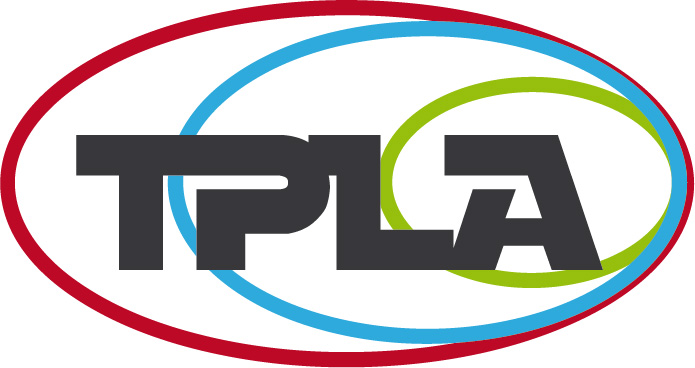
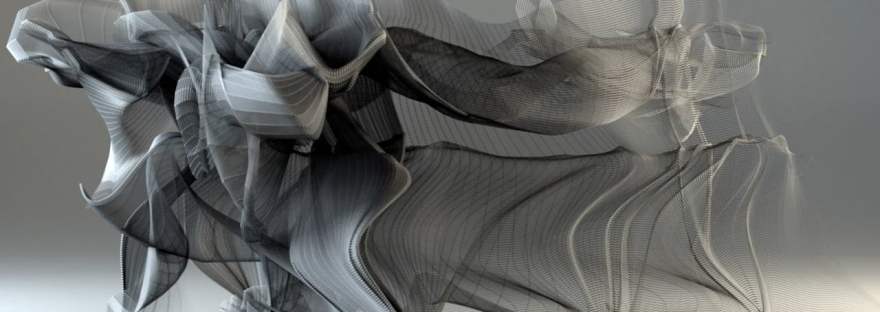

Very clear and helpful post. Thank you, Chad.
LikeLike
Very helpful post Chad, thanks!
LikeLike
I translate it in Italian. Thanks Chad
in https://meihuazhuang.wordpress.com/2022/08/04/catene-cinetiche-scienza-del-movimento-e-arti-marziali-tradizionali/
LikeLike
I am honored!
LikeLike